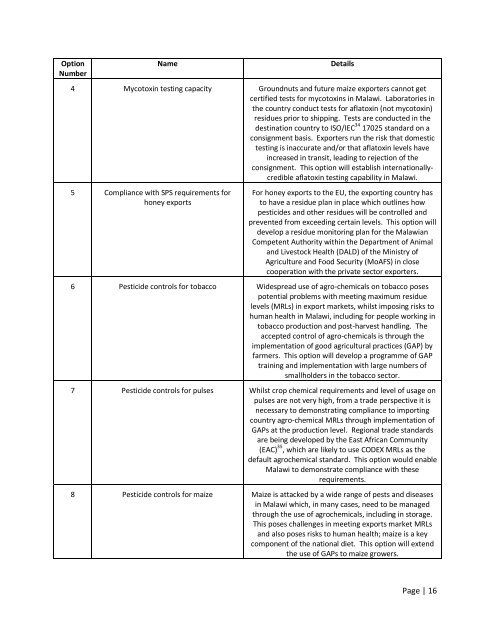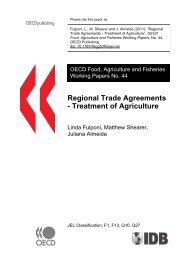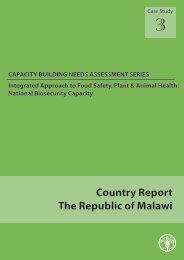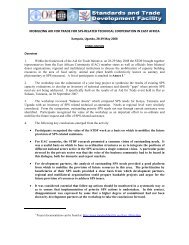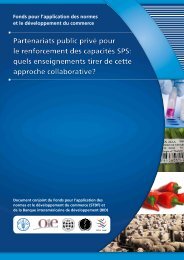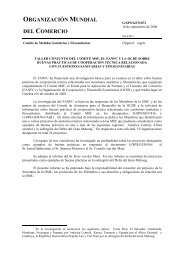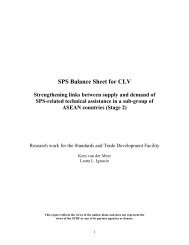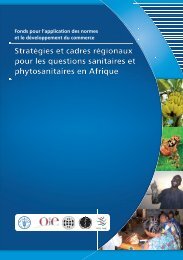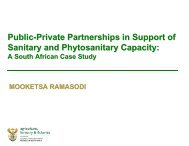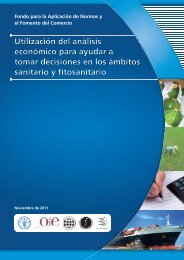MCDA Final Report Malawi - Standards and Trade Development ...
MCDA Final Report Malawi - Standards and Trade Development ...
MCDA Final Report Malawi - Standards and Trade Development ...
You also want an ePaper? Increase the reach of your titles
YUMPU automatically turns print PDFs into web optimized ePapers that Google loves.
Option<br />
Number<br />
Name<br />
Details<br />
4 Mycotoxin testing capacity Groundnuts <strong>and</strong> future maize exporters cannot get<br />
certified tests for mycotoxins in <strong>Malawi</strong>. Laboratories in<br />
the country conduct tests for aflatoxin (not mycotoxin)<br />
residues prior to shipping. Tests are conducted in the<br />
destination country to ISO/IEC 34 17025 st<strong>and</strong>ard on a<br />
consignment basis. Exporters run the risk that domestic<br />
testing is inaccurate <strong>and</strong>/or that aflatoxin levels have<br />
increased in transit, leading to rejection of the<br />
consignment. This option will establish internationallycredible<br />
aflatoxin testing capability in <strong>Malawi</strong>.<br />
5 Compliance with SPS requirements for<br />
honey exports<br />
For honey exports to the EU, the exporting country has<br />
to have a residue plan in place which outlines how<br />
pesticides <strong>and</strong> other residues will be controlled <strong>and</strong><br />
prevented from exceeding certain levels. This option will<br />
develop a residue monitoring plan for the <strong>Malawi</strong>an<br />
Competent Authority within the Department of Animal<br />
<strong>and</strong> Livestock Health (DALD) of the Ministry of<br />
Agriculture <strong>and</strong> Food Security (MoAFS) in close<br />
cooperation with the private sector exporters.<br />
6 Pesticide controls for tobacco Widespread use of agro-chemicals on tobacco poses<br />
potential problems with meeting maximum residue<br />
levels (MRLs) in export markets, whilst imposing risks to<br />
human health in <strong>Malawi</strong>, including for people working in<br />
tobacco production <strong>and</strong> post-harvest h<strong>and</strong>ling. The<br />
accepted control of agro-chemicals is through the<br />
implementation of good agricultural practices (GAP) by<br />
farmers. This option will develop a programme of GAP<br />
training <strong>and</strong> implementation with large numbers of<br />
smallholders in the tobacco sector.<br />
7 Pesticide controls for pulses Whilst crop chemical requirements <strong>and</strong> level of usage on<br />
pulses are not very high, from a trade perspective it is<br />
necessary to demonstrating compliance to importing<br />
country agro-chemical MRLs through implementation of<br />
GAPs at the production level. Regional trade st<strong>and</strong>ards<br />
are being developed by the East African Community<br />
(EAC) 35 , which are likely to use CODEX MRLs as the<br />
default agrochemical st<strong>and</strong>ard. This option would enable<br />
<strong>Malawi</strong> to demonstrate compliance with these<br />
requirements.<br />
8 Pesticide controls for maize Maize is attacked by a wide range of pests <strong>and</strong> diseases<br />
in <strong>Malawi</strong> which, in many cases, need to be managed<br />
through the use of agrochemicals, including in storage.<br />
This poses challenges in meeting exports market MRLs<br />
<strong>and</strong> also poses risks to human health; maize is a key<br />
component of the national diet. This option will extend<br />
the use of GAPs to maize growers.<br />
Page | 16


